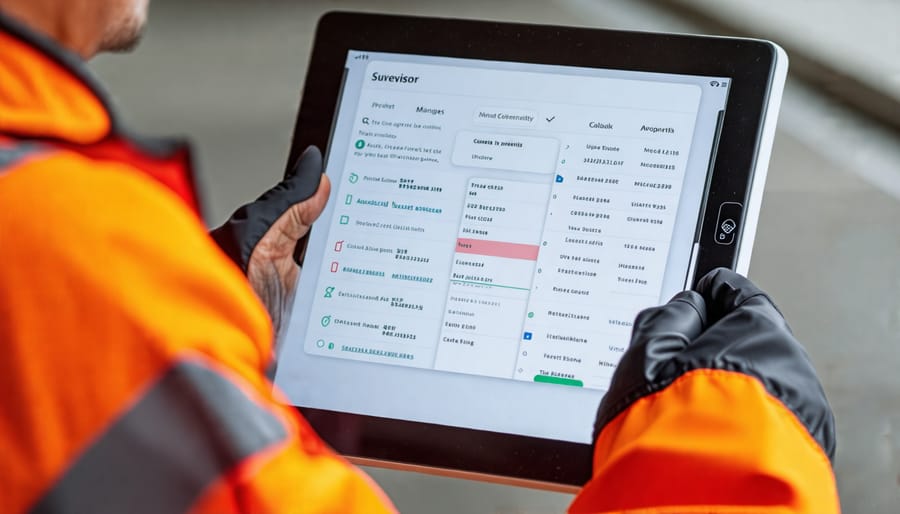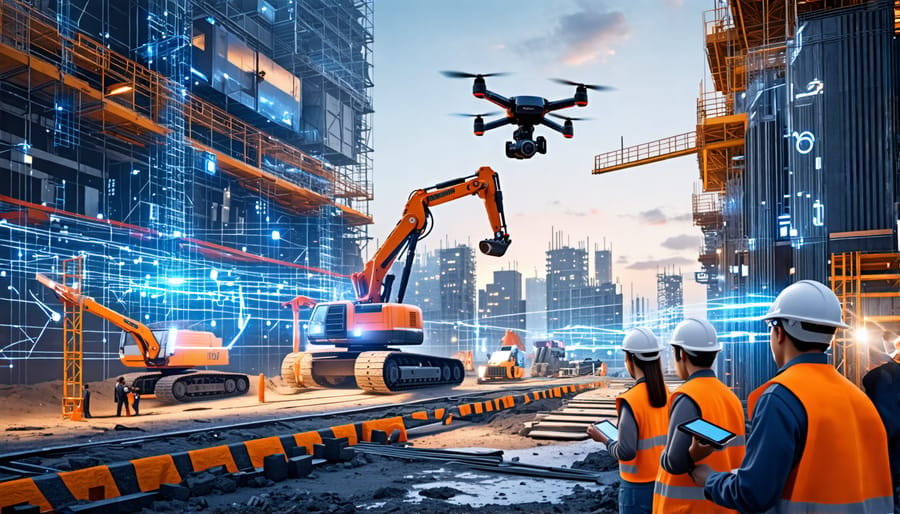Harness the power of digital technologies to revolutionize your construction business. From Building Information Modeling (BIM) and 3D printing to IoT sensors and drones, digital transformation is reshaping how we design, build and maintain structures. Embrace these cutting-edge tools to streamline processes, reduce costs, enhance collaboration and deliver projects faster than ever before. The future of construction is digital – and those who adapt now will lead the industry tomorrow.
Key Areas of Digital Disruption
Building Information Modeling (BIM)
Building Information Modeling (BIM) is revolutionizing the way construction projects are designed, planned, and executed. By creating a digital representation of the physical and functional characteristics of a building, BIM enables architects, engineers, and contractors to collaborate more effectively throughout the project lifecycle. With BIM, teams can detect and resolve design conflicts early on, reducing costly rework and delays. The 3D modeling capabilities of BIM software allow for more accurate and detailed visualizations, enabling better decision-making and client communication. BIM also facilitates seamless data exchange between project stakeholders, ensuring everyone has access to the most up-to-date information. Moreover, BIM can be used to simulate construction processes, optimize schedules, and improve resource allocation. By leveraging the power of BIM, construction firms can enhance project efficiency, minimize risks, and deliver higher-quality outcomes. As the industry continues to embrace digital transformation, BIM will play an increasingly critical role in driving innovation and competitiveness.

Cloud and Mobile Technologies
Cloud computing and mobile technologies are revolutionizing the way construction projects are managed and executed. By leveraging the power of the cloud, construction firms can centralize data storage, enabling seamless collaboration and real-time access to critical information from anywhere, at any time. This eliminates the need for physical data storage and reduces the risk of data loss or inconsistencies.
Mobile apps, powered by cloud technology, are transforming communication and workflow efficiency on construction sites. Field workers can now access and update project data, blueprints, and schedules directly from their smartphones or tablets, streamlining processes and reducing the potential for errors. Real-time updates and notifications keep everyone on the same page, facilitating better coordination between teams and faster decision-making.
Cloud-based project management platforms provide a single source of truth for all stakeholders, from architects and engineers to contractors and subcontractors. These platforms enable efficient document management, version control, and change order tracking, minimizing delays and disputes. Additionally, mobile apps allow for on-site inspections, safety checks, and quality control, with the ability to capture photos, videos, and annotations in real-time.
By embracing cloud and mobile technologies, construction firms can improve productivity, reduce costs, and enhance the overall quality of their projects. These digital tools are essential for staying competitive in an increasingly technology-driven industry.


Internet of Things (IoT) and Smart Sensors
The Internet of Things (IoT) and smart sensors are revolutionizing the construction industry by enabling real-time monitoring, predictive maintenance, and enhanced safety on job sites. IoT devices, such as wearables, drones, and connected equipment, collect vast amounts of data that provide valuable insights into project progress, resource utilization, and potential issues. By analyzing this data, construction teams can optimize workflows, reduce waste, and improve overall efficiency. Smart sensors embedded in structures and equipment can detect early signs of wear and tear, allowing for proactive maintenance and preventing costly downtime. Additionally, IoT technology enhances worker safety by monitoring environmental conditions, detecting potential hazards, and alerting personnel to unsafe situations. Wearable devices can track worker location, vital signs, and exposure to harmful substances, ensuring their well-being on the job site. As the construction industry continues to embrace digital transformation, the integration of IoT and smart sensors will become increasingly essential for staying competitive, mitigating risks, and delivering high-quality projects on time and within budget.
Robotics and Automation
Robotics and automation are revolutionizing the construction industry, offering unprecedented opportunities to boost productivity, reduce costs, and enhance safety on job sites. Emerging applications such as 3D printing and prefabrication are gaining traction, enabling faster, more precise, and less labor-intensive construction processes.
3D printing technology allows for the rapid creation of complex structures and components, from concrete walls to intricate architectural elements. By automating the fabrication process, construction companies can minimize waste, reduce labor requirements, and achieve higher levels of customization and design flexibility.
Prefabrication, or off-site construction, involves manufacturing building components in a controlled factory environment before assembling them on-site. This approach minimizes weather-related delays, improves quality control, and reduces the need for skilled labor on the job site. Prefabricated modules can be produced more efficiently and with greater precision, leading to faster project completion times and lower overall costs.
Robotics are also making inroads in the construction industry, with autonomous machines and robotic arms performing tasks such as bricklaying, welding, and material handling. These advanced systems can work tirelessly and with unparalleled accuracy, reducing the risk of human error and increasing overall efficiency. As robotics technology continues to evolve, it has the potential to transform the construction landscape, enabling companies to take on more complex projects while ensuring consistent quality and safety standards.
Benefits and Challenges
The digital transformation of the construction industry offers numerous benefits, including increased efficiency, improved collaboration, and enhanced project outcomes. By leveraging digital tools and technologies, construction firms can streamline processes, reduce waste, and optimize resource allocation. For example, Building Information Modeling (BIM) enables teams to create detailed digital representations of projects, facilitating better coordination and clash detection. Additionally, the use of cloud-based platforms and mobile devices allows for real-time data sharing and communication among stakeholders, leading to faster decision-making and reduced delays.
However, embracing digital transformation also presents challenges and risks that construction companies must navigate. One significant obstacle is the initial cost of implementing new technologies and training employees to use them effectively. Resistance to change within organizations can also hinder adoption, as some individuals may be hesitant to abandon traditional methods. Furthermore, the construction industry faces a skills gap, with a shortage of professionals well-versed in emerging technologies. Cybersecurity risks are another concern, as the increasing reliance on digital systems makes construction firms more vulnerable to data breaches and cyber attacks.
To successfully overcome these challenges, construction companies must develop a clear digital strategy, invest in employee training and upskilling, and foster a culture of innovation and continuous improvement. Partnering with technology providers and engaging in pilot projects can help mitigate risks and ensure a smooth transition. By carefully weighing the benefits and challenges of digital transformation, construction firms can position themselves for long-term success in an increasingly competitive and technology-driven industry.
Case Studies
One compelling case study of successful digital transformation in the construction industry is the story of Bechtel, a global engineering, construction, and project management company. Bechtel embraced digital technologies to streamline processes, enhance collaboration, and improve project outcomes. By implementing a cloud-based platform for project management, Bechtel was able to centralize data, enable real-time collaboration among teams, and gain better visibility into project progress. This digital initiative resulted in significant improvements in efficiency, cost savings, and project delivery times.
Another notable example is the digital transformation journey of Skanska, a multinational construction and development company. Skanska recognized the potential of emerging technologies like Building Information Modeling (BIM), Internet of Things (IoT), and data analytics to revolutionize their operations. They invested in developing a robust digital infrastructure, including a cloud-based BIM platform, which allowed seamless collaboration between architects, engineers, and construction teams. By leveraging IoT sensors and advanced analytics, Skanska was able to monitor project sites in real-time, optimizing resource allocation and proactively addressing potential issues. These digital initiatives have helped Skanska to enhance productivity, reduce rework, improve safety, and deliver projects more efficiently.
These case studies demonstrate the tangible benefits that construction firms can realize by embracing digital transformation. By adopting cutting-edge technologies and integrating them into their workflows, companies like Bechtel and Skanska have positioned themselves as industry leaders, setting a powerful example for others to follow in the pursuit of digital excellence.
Conclusion
The digital transformation in the construction industry is a complex and ongoing process, but embracing change is essential for companies looking to thrive in the modern market. As we have seen, the adoption of technologies such as BIM, IoT, AR/VR, drones, and 3D printing can lead to significant improvements in efficiency, safety, and sustainability. However, these benefits come with challenges, including the need for upskilling, data security concerns, and the initial costs of implementation.
Real-world examples demonstrate that construction firms willing to invest in digital solutions and adapt their processes are reaping the rewards. From reduced project timelines and costs to improved collaboration and decision-making, the advantages of digital transformation are clear. As the industry continues to evolve, staying ahead of the digital curve will be crucial for construction companies looking to remain competitive.
In conclusion, the digital transformation of the construction industry is not a trend to be ignored. By embracing the power of technology and committing to continuous improvement, construction professionals can position themselves for success in an increasingly digital world. The future of construction is here, and those who adapt will be the ones to shape it.

